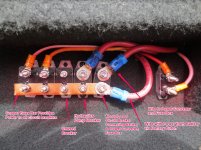Ann&Ted
Well-known member
I have a 2015 LM-365 Newport. Per the VIN, it was manufactured in mid 2014. I believe I may have a battery issue. I have several comments and question.
1. I keep the RV plugged into a 50 amp service.
2. An issue came up this morning when the kitchen slide did not want to open. After several attempts of pushing the switch between open and close, the slide finally opened. All three slides opened, but seemed to strain doing so.
2. I pressed the start button on the inverter control panel in the RV and it showed 11.5 VDC and then indicated an E02 error while beeping.
3. The bathroom exhaust fan will not start. Both other fans run fine.
Q1. Should the batteries be charged while the RV is plugged into the 50 amp supply.
Q2. If the answer above is yes, shouldn't the inverter control panel indicate a proper voltage and and show an error condition? Previously, the highest voltage I saw on the control panel was 12.5 VDC.
My concern is that the batteries may be defective at this time and will not take or hold a charge. I purchased the LM-365 in June of this year, so it was a year old already. That means, it sat on a lot without being plugged into a 50 amp service. Then, the last time I had it in for service, it sat for 3 weeks without being plugged. The batteries were dead when I picked it up from the dealer. They had to put a quick charge on the batteries long enough for me to raise the unit to hitch up to the truck. I charged the batteries for several days and they never really charged fully.
Your answers and comments will be most welcome.
1. I keep the RV plugged into a 50 amp service.
2. An issue came up this morning when the kitchen slide did not want to open. After several attempts of pushing the switch between open and close, the slide finally opened. All three slides opened, but seemed to strain doing so.
2. I pressed the start button on the inverter control panel in the RV and it showed 11.5 VDC and then indicated an E02 error while beeping.
3. The bathroom exhaust fan will not start. Both other fans run fine.
Q1. Should the batteries be charged while the RV is plugged into the 50 amp supply.
Q2. If the answer above is yes, shouldn't the inverter control panel indicate a proper voltage and and show an error condition? Previously, the highest voltage I saw on the control panel was 12.5 VDC.
My concern is that the batteries may be defective at this time and will not take or hold a charge. I purchased the LM-365 in June of this year, so it was a year old already. That means, it sat on a lot without being plugged into a 50 amp service. Then, the last time I had it in for service, it sat for 3 weeks without being plugged. The batteries were dead when I picked it up from the dealer. They had to put a quick charge on the batteries long enough for me to raise the unit to hitch up to the truck. I charged the batteries for several days and they never really charged fully.
Your answers and comments will be most welcome.


